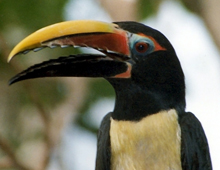Sloth Forest

Red howler monkey, Alouatta seniculus
At times, the DWA troop of Red howler monkeys, unique in North America, are heard long before they are seen. The mechanical-sounding, rumbling growl is produced by an enormous larynx (voice box) and can be heard three miles away. The only animal sound that is louder is made by Blue whales. The howlers are often next to the ceiling of their high enclosure. While this South American primate was notorious for being difficult to keep in zoos, it has done well at the DWA, where a number have been born and raised.
LEARN MORE
Brown-throated three-toed sloth, Bradypus variegatus
Almost all mammals have seven cervical vertebrae (the bones in the neck); manatees have six, two-toed sloths have five and three-toed sloths have nine. They also have no gall-bladder nor appendix, and cannot regulate their body temperature. Their teeth all look like molars, with no incisors. Throughout their Central and South American range, they live entirely upon leaves. Because the DWA provides a constant supply of Cecropia leaves, our male, “Leno”, has thrived here since 2005, setting the captive age record outside of Tropical America.
LEARN MORE
Pygmy marmoset, Callithrix pygmaea
The smallest New World primate, also the smallest monkey, weighs less than five ounces (the only smaller primates are several Madagascan lemurs). Pygmy marmosets occupy a rather large range in the forests of Western South America. Formerly rather rare in zoos, its captive population is now well managed with more than 700 world-wide, mostly captive-bred. It is usual for twins to be born. Despite their tiny size, they can live 20 years in captivity. In the wild, they specialize in eating gummy sap. In captivity, they do quite well on the same diets that larger marmosets and tamarins receive: a manufactured primate diet, fresh fruits and vegetables, and insects.
LEARN MORE
Green aracari, Pteroglossus viridis
Before the 1980s, this small toucan from Northeastern South America was very rare in captivity. Since the first captive breeding took place in 1980, in a California private aviary, hundreds have been hatched in the US, and the captive population appears to be self-sustaining. Those in zoos are carefully monitored for genetic diversity through a Species Survival Plan (SSP) of the Association of Zoos and Aquariums (AZA), and many others are kept privately. Since 2001, more than 50 have hatched at the DWA. This is one of the few toucans whose sexes can be easily distinguished; males have black heads and the females have brown heads.
LEARN MORE

